Lorenzo De Ferrari's 18th-century splendors in Palazzo Tobia Pallavicino in Genoa
A few days ago we took you on a discovery of a piece of Raphaelesque culture in Genoa: the frescoes by Giovanni Battista Castello, known as the Bergamasco, in Palazzo Tobia Pallavicino. Before we got to talking about the paintings, we had also given you a little bit about the history of the building, which was commissioned by one of the richest patricians of mid-sixteenth-century Genoa (Tobia Pallavicino, to be precise). And we told you that, over the following centuries, the palace changed owners. In fact, the Pallavicino family resided in the building until the early eighteenth century: then, in 1704, a descendant of Tobia, Ignazio Pallavicino, sold the palace to Marquis Giacomo Filippo Carrega. As the Cataldi barons took over the property in 1830, the building is now also known as Palazzo Carrega-Cataldi. Well: going back to the 18th century, it is necessary to start by saying that the Carrega family initiated a series of extensions. Between 1710 and 1714, the palace was raised by one floor, while a few years later Giambattista Carrega, son of Giacomo Filippo, endowed the building with two new wings and an inner courtyard.
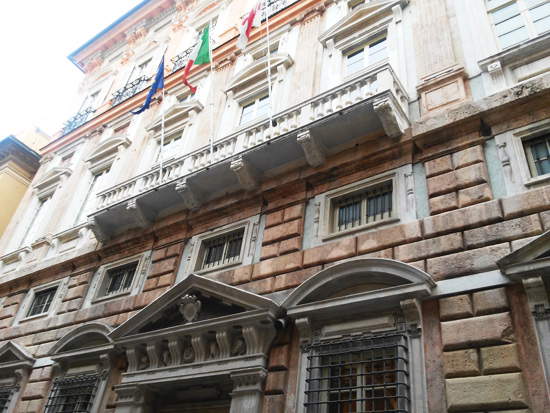 |
| The facade of Palazzo Tobia Pallavicino |
It is entirely fair to imagine that the new spaces needed to be adequately decorated: and Giambattista Carrega, having completed work on the structure, wasted no time. One of the new spaces was the Palace’s Gentile Chapel, which was built in the second phase of the extension work, that is, between 1727 and 1746 (but was finished, however, well before the latter date). This is a very special space indeed, and to better understand its history it is necessary to dwell for a few moments on the beautiful Madonna and Child that we find inside. Let us make it clear from the outset that it is a copy of the original that the Carrega family purchased for the palace: the latter sculpture, the work of an important French artist, Pierre Puget, has in fact known several movements. The work was sculpted around 1680 for a Genoese nobleman, probably a member of the influential Balbi family, since documents attest us to its presence, in 1717, in a palace belonging precisely to the Balbi family. Purchased later, as mentioned, by the Carrega family, it was placed in the palace chapel, but left it when the building was purchased by the Cataldi family. It then passed into the collections of the entrepreneur and collector Luigi Frugone, and was donated by the latter to the city in 1937 and was thus destined for the Museum of St. Augustine. In order to fill the void left in the chapel of Palazzo Tobia Pallavicino, the Chamber of Commerce, in 2004, decided to place the copy in the space once occupied by the original.
It is not far-fetched to speculate that the decoration of the chapel was designed precisely for the purpose of emphasizing Pierre Puget’s work. And to bring the operation to fruition, the Carrega family called in one of the Genoese painters most in vogue in the first half of the eighteenth century: Lorenzo De Ferrari (Genoa, 1680 - 1744). We are around 1740: the artist conceived a strikingly scenic layout. Entering the small chapel, one almost has the impression that there is adeep apse on the back wall, punctuated by a series of gilded columns supporting a sumptuous (but light) Rococo entablature, while a hilly landscape opens up in the background. At the center of this structure, right in the middle of the semicircle created by the columns, the statue of Puget is hit by artificial light so that it stands out against the background. If we push on to take a closer look at the colonnade on the back wall, we will notice that this is nothing more than an illusionistic effect: there is actually no apse, and the depth of the space is sufficient to accommodate just the statue. Lorenzo De Ferrari made his gilded stucco columns by shaping them in such a way as to give the viewer theillusion of depth: a striking trompe l’oeil (by which term we refer to this kind of painting, which is intended to deceive the eye of the viewer: the expression really means “deceive the eye”), which deludes us into thinking that we are in front of a space that is much wider than it actually is. And to increase the effect, a mirror has been placed on the opposite wall in which the mock apse is reflected, so that the proportions of the space seem to become larger.
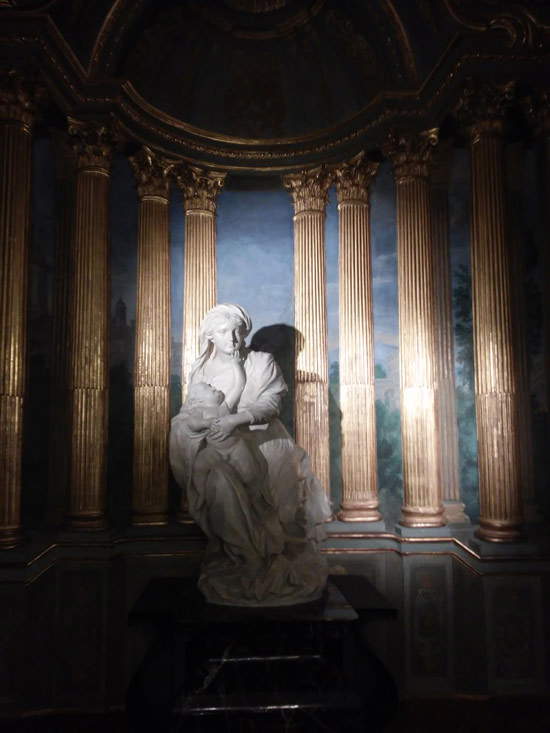 |
| The aristocratic chapel of Palazzo Tobia Pallavicino (or Palazzo Carrega-Cataldi). Architecture painted by Lorenzo De Ferrari (ca. 1740), statue by Pierre Puget (copy) |
Mirrors were, after all, used unsparingly in Rococo decorations, precisely for the purpose of creating dramatic effects and impressing the observer. And abundant use is made of mirrors in the most important of the rooms decorated by Lorenzo De Ferrari in the Palazzo: the famous Galleria Dorata, the realization of which dates back to the years 1743-1744. A temporal placement that would make the undertaking the last work of the Genoese artist’s life. It is one of the greatest masterpieces of Ligurian Rococo: indeed, one of the greatest art historians of the last century, Rudolf Wittkower, called the Galleria Dorata “one of the most sublime creations of the whole eighteenth century.” The importance of this environment transcends, in short, the boundaries of the city, the region, and perhaps even Italy: and to understand why, it is enough to go inside. The Galleria Dorata presents itself to us as a unique room, filled with those gilded stuccoes, designed by Lorenzo De Ferrari himself and probably made by the stucco artist Diego Carlone, that give the room its name and frame the paintings of the Genoese artist. Putti, winged virtues, festoons, garlands, and shells come together in a dazzling weave that moves all visitors to this sumptuous room in wonder, and which De Ferrari designed on purpose to give, as in the Chapel, the idea of being in a room that appears even larger than it actually is. In fact, the artist thought of placing numerous mirrors in the room, which could reflect the gold of the stuccoes in such a way as to enhance the natural light coming from the windows: the feeling is that of being, in short, in a sparkling gallery, filled with light.
A mirror is also placed on the large table in the center of the room: and it not only serves a scenic function, but almost acts as an enormous magnifying glass, as its surface perfectly reflects the airy fresco of the vault, also the work of Lorenzo De Ferrari, allowing us to study it in great detail. For the palace’s most sumptuous room, the patrons wanted a series of paintings that could celebrate, in a literary key, their classical culture: the cycle is in fact dedicated to the Stories of Aeneas.
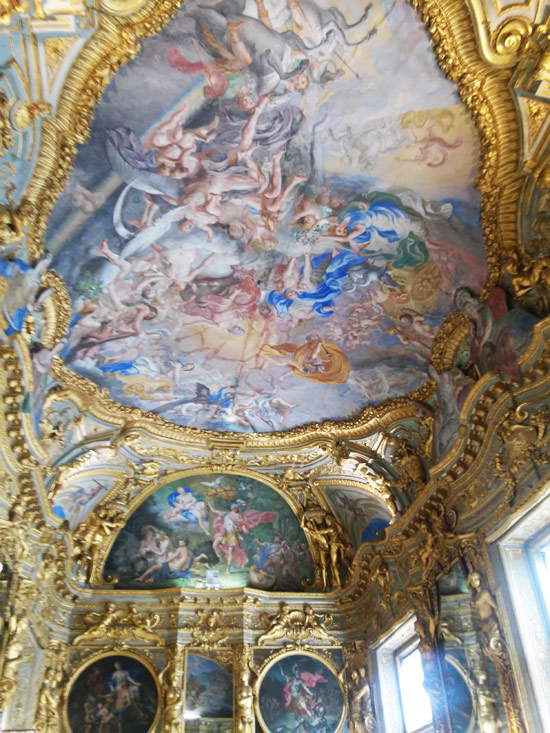 |
| The Gilded Gallery |
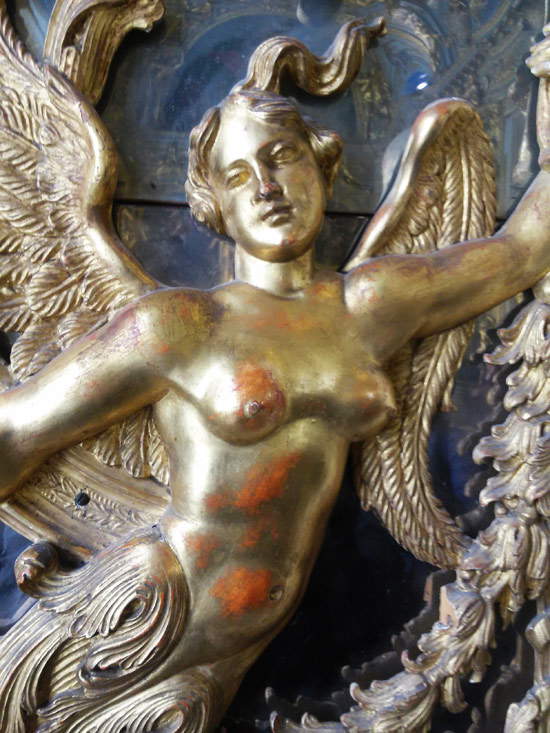 |
| Winged Virtue, detail of the stucco work in the Gilded Gallery |
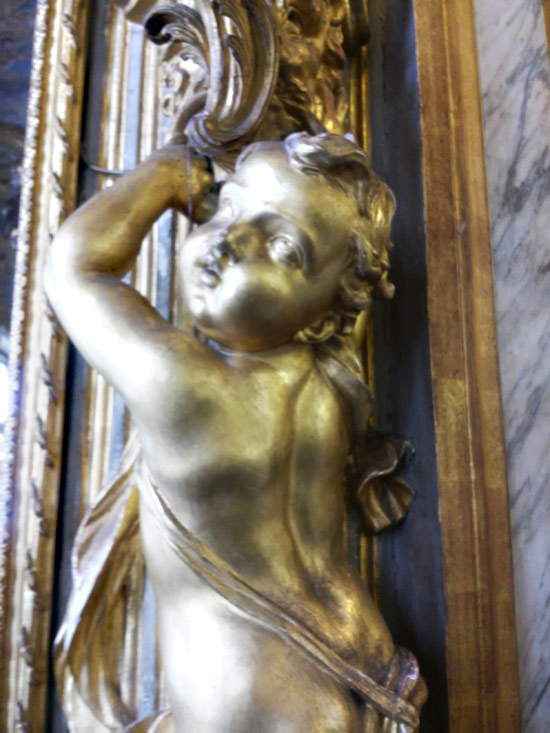 |
| Putto, detail of the stuccoes of the Gilded Gallery |
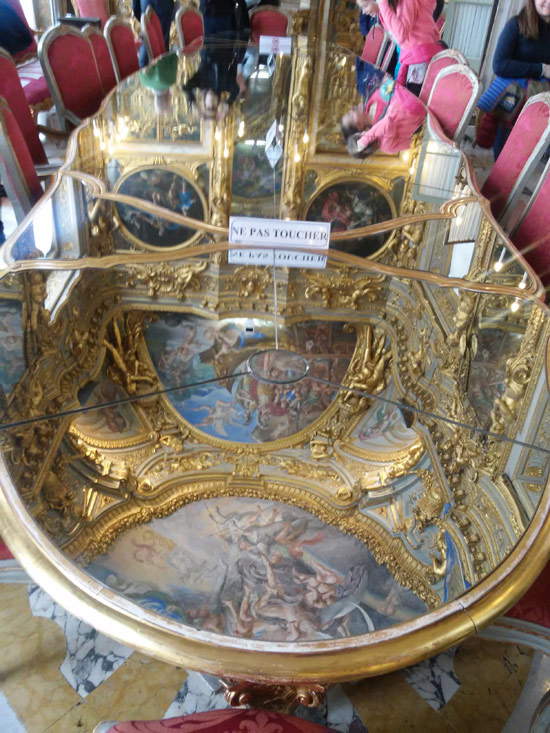 |
| The table with mirror in the center of the Gallery |
The vault depicts a crowded Olympus, which appears to us furrowed by two conspicuous cracks: these are the scars left, unfortunately, by the bombing that hit the palace on November 7, 1942, during World War II. In the center of the painting, Zeus, the king of the gods, holds his scepter, while all around him all the deities of Greco-Roman mythology are easily recognizable: Dionysus, the Bacchus of the ancient Romans, has his head crowned with vine leaves and carries a vine-shoot filled with bunches of white grapes. Below him we have Kronos, recognizable by his showy wings and scythe, while above Zeus we recognize Hermes, who comes flying in winged shoes. Behind Zeus, dressed as a soldier, here is Ares, god of war, while beside the king of Olympus we see a beautiful Aphrodite (Venus, for the Romans) together with Cupid, who, holding his bow, his typical iconographic attribute, leans on his mother’s bare leg. Venus is coming running, and she turns to Jupiter with a pleading look: she is in fact asking for protection for Aeneas, and the gesture of her right hand, which seems to point to the earth, should leave no doubt as to her intentions.
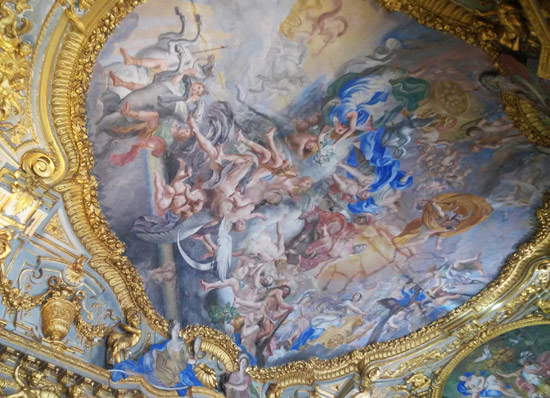 |
| Lorenzo De Ferrari, Olympus (1743-1744; fresco; Genoa, Palazzo Tobia Pallavicino) |
Aeneas, as mentioned, is the great protagonist of the cycle of paintings: the two frescoed lunettes and the four roundels on canvas in fact narrate his exploits. The lunette in the wall that remains on our right when we enter the Gallery shows us Aeneas landing in Latium after his wanderings while fleeing from Troy, while the two tondi below present us, on the left, with the hero leaving the city with his wife and son Ascanius, carrying his father Anchises on his shoulders: Lorenzo De Ferrari scrupulously adheres to the narrative that Virgil eternalized in his Aeneid. The next moment in the story offers us Aeneas with Dido, and we see this in the tondo on the right. The iconographic program, however, did not call for too much space to be left for the troubled love affair between the two: thus, on the opposite wall, the lunette depicts the Trojan hero finding the golden olive branch that, according to the instructions given to him by the Cumaean Sibyl, would make it easier for him to leave the underworld, where he had descended to meet his recently dead father (and where he would later meet Dido, who died by suicide after his abandonment). Anchises would show him the souls waiting to incarnate and destined to become great. This would have been possible, however, only through the enterprise of Aeneas, who then went to Latium: the tondo on the left depicts him receiving weapons from Venus, in preparation for the battle he and his companions would face against the Ruthuli, led by their king Turno. In the last tondo, Lorenzo De Ferrari paints the final confrontation between Aeneas and Turnus: the Trojan hero prevails, kills his rival in battle, and is able to allow the Trojans to settle in Latium and start the lineage from which the history of Rome is traditionally made to begin.
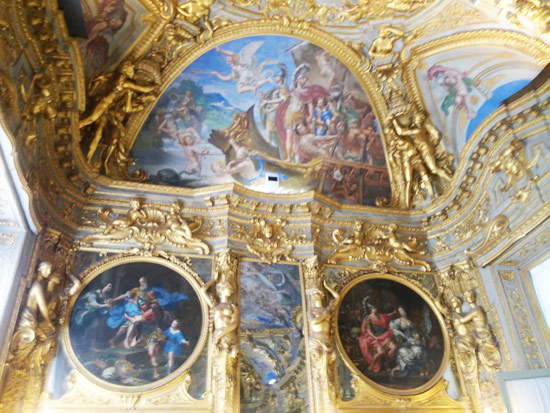 |
| Lorenzo De Ferrari, Stories of Aeneas (1743-1744; frescoes and oil paintings on canvas; Genoa, Palazzo Tobia Pallavicino). Top: Aeneas lands in Latium (fresco). Tondo left: escape from Troy (oil on canvas). Tondo right: Aeneas and Dido (oil on canvas). |
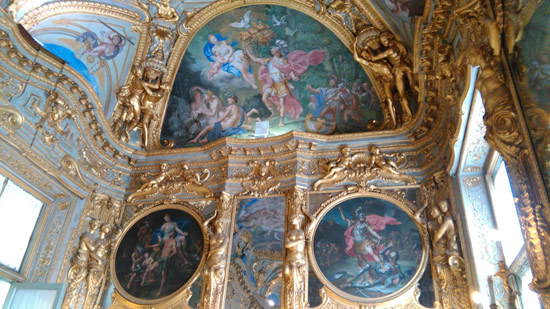 |
| Lorenzo De Ferrari, Stories of Aeneas (1743-1744; frescoes and oil paintings on canvas; Genoa, Palazzo Tobia Pallavicino). Above: the gilded olive tree (fresco). Tondo at left: Aeneas receives arms from Venus (oil on canvas). Tondo right: Aeneas defeats Turno in battle (oil on canvas). |
The poses of the characters are theatrical and evoke attitudes typical of statuary, and it is not uncommon to find references to classical statuary: note, for example, the nymphs near Aeneas in the scene of the golden olive tree, modeled after the example of the river allegories of classical art. Acting as a counterbalance to the three river nymphs is the goddess Venus, who, together with Cupid, appears immediately above: the Rococo grace and lightness with which she sits on the cloud and holds her son by the hand in an attempt to put him to sleep is as far from the almost monumental solemnity of the group we see immediately below. Somewhere between these two tendencies is the figure of Aeneas: triumphant like an ancient hero, but also light and supple as per typical eighteenth-century stylistic features (although his effeminate demeanor and his cloak flying in all directions help to unbalance the two components toward the more markedly Rococo one). This is Lorenzo De Ferrari’s last masterpiece: an exuberant set design in a constant balance between classicism and rococo, painstakingly detailed (the artist made numerous drawings for each individual work, studying the characters’ attitudes, poses, and compositions with meticulous attention) and involving every element (the furniture itself is an integral part of the setting), so that even we who enter the Galleria Dorata are involved to the fullest.
From Raphaelesque grace to Rococo splendor, from the grotesques of Bergamasco to the stuccoes of Lorenzo De Ferrari, Palazzo Tobia Pallavicino (or, if you prefer, Palazzo Carrega-Cataldi) is one of Genoa’s most precious treasure chests: a little-known treasure chest, however, in which it is possible to see how taste changed over the centuries (and according to the inclinations of the patrons), as well as some of the masterpieces of two of the artists who made great a city that never ceases to surprise those who visit it.
Reference bibliography
- AA.VV., Genova Palazzo Tobia Pallavicino, Sagep, 2013
- Cristina Bartolini, Gianni Bozzo, Genoa: Palazzo Carrega Cataldi, Sagep, 2000
- Rudolf Wittkower, Art and architecture in Italy, 1600 to 1750, Yale University Press, 1999 (fourth edition)
- AA.VV., Pierre Puget (Marseilles 1620-1694): a French artist and Baroque culture in Genoa, exhibition catalog (Marseilles, Centre Vieille Charité and Musée des Beaux-Arts, October 28, 1994 - January 30, 1995), Mondadori Electa, 1995
- Emanuela Brignone Cattaneo, Roberto Schezen, Genoa: historic buildings and grand residences, Allemandi, 1992
- Ezia Gavazza, La grande decorazione a Genova, Sagep, 1974
- Pietro Torriti, Treasures of Strada Nuova: the Via Aurea of the Genoese, Sagep, 1971
- Ezia Gavazza, Lorenzo De Ferrari (1680-1744), Edizioni La Rete, 1965
Warning: the translation into English of the original Italian article was created using automatic tools. We undertake to review all articles, but we do not guarantee the total absence of inaccuracies in the translation due to the program. You can find the original by clicking on the ITA button. If you find any mistake,please contact us.



























